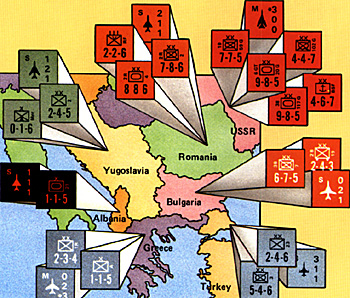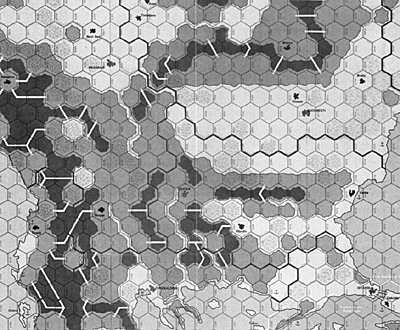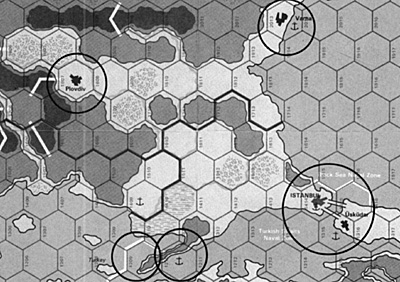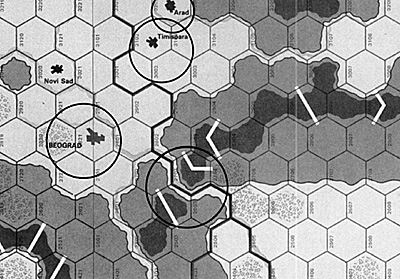
Warsaw Pact Forces
Infantry Deployment:
Initial set-up for the Pact forces is important but not overly critical. The front is narrow enough that rapid movement between major objectives is possible. However, there are certain hexes in which units should be placed. Since Jugoslav neutrality is an unknown factor until turn four, one Romanian unit should be left in Timisoara (hex D-I 302) to protect it and the adjoining city from Jugoslav attack. A lone unit cannot hold off the whole jugoslav army, but the unit will gain you time for reinforcements to arrive. The Romanian mountain unit should be placed in hex D-2703 to stall any enemy move through the pass in D- 2602.
Initial Soviet units should be airlifted and sealifted to the front. In fact, the Soviet Marine unit could be left in Odessa or Varna for the time when you may want to land them behind Turkish lines. The Soviet Mechanized Airborne unit can be airlifted to Plovdiv, where it will be available for combat at the front or an airborne assault. The Bulgarian airborne unit should be placed in Sofiya, where it will be available for any paradrop action and will be able to protect the Bulgarian capital from Jugoslav attack. One last thing to remember about initial deployment is to stack your units by armies. This maximizes stacking and, of course, firepower.
 Air Deployment:
Air Deployment:
During the initial phases of turn one, try to knock out the enemy air force through runway cratering. In air-to-air combat you will have to be lucky to shoot down any enemy aircraft. If you are successful, it will be very hard for NATO to recover as they get very few reinforcements and have the possibility of losing the F-14's to withdrawal. Keep the pressure on and attempt to get air superiority every turn. Due to the poor Pact maintenance, this is not always possible. However sooner or later your numbers should win out.
Air superiority is critical if you want to conduct your airborne assault and ground support missions unmolested. To help achieve this superiority, transfer your aircraft that are in the Southwest theater to the Balkans at the end of turn one. If the Jugoslavs have not attacked by then, you will not need any aircraft in the Southwest until at least turn four. If not needed then, the aircraft will never be needed there.
Soviet Objectives
On the ground, you will be tempted to attack and "shake" the Greeks during the first turn. Don't do it. Your strategy should be to concentrate on the Turks, so that the Black Sea Fleet can sortie. Push for Istanbul and never let off on the pressure. Leave a weak screening force to cover the Greeks. You may have some trouble with them, but your revenge will be soon in coming. Once you receive the massive Soviet reinforcements in turn three, send your Bulgarian and Romanian units to Greece.
 By this time, the Turkish front should be
reduced to the two hexes in front of
Istanbul. Keep feeding fresh Soviet
units into these hexes; when a Soviet
unit becomes disrupted, pull it out of the
line and let it regroup. Never allow the
defenders of Istanbul a moment's rest.
By this time, the Turkish front should be
reduced to the two hexes in front of
Istanbul. Keep feeding fresh Soviet
units into these hexes; when a Soviet
unit becomes disrupted, pull it out of the
line and let it regroup. Never allow the
defenders of Istanbul a moment's rest.
Once the Soviet units are in place in front of Istanbul, use your airmobile, airborne and marine troops to isolate the city. Don't forget to post a unit in D-1209 or D-1210 so the straits will be isolated too. Although Turkish units in the area can still use Istanbul and Uskudar for communications, all U.S. and French units will be reduced in proficiency. This maneuver also keeps most units in enemy zones of control, denying them the ability to regroup. Use your airmobile units carefully, though, as they are vulnerable to attack.
Other Rules Considerations:
Tactically, there are certain things that will also aid your cause. Following attacks during the First Echelon Sub- Impulse, do not advance after combat unless the advancing units are already in an enemy zone of control or there is a geographic objective along the line of retreat. This will allow you to have more units available for the attacks during the Second Echelon/Breakthrough Sub- Impulse. After attacks during this Second SubImpulse, use advance after combat to the fullest. This will tie up the maximum number of NATO units and render them incapable of counterattacking. This policy must be used with discretion during the Pact Second Impulse.
Avoid any incursions into Jugoslavia. Though relatively weak, once activated the Jugoslav partisans will be a lot tougher to crack than the Greeks. Valuable time will be lost trying to subdue a country that is not the primary objective. If and when Jugoslavia enters the conflict voluntarily, it must be dealt with. If the Jugoslavians enter on turn one, use some token holding forces and protect the Romanian and Bulgarian cities. Once the Soviet reinforcements arrive on turn three, or i ' 'he jugoslavs enter on turn four, crush them with the Romanians, Bulgarians and a few selected Soviets.

NATO
Initial Deployment
Although the forces arrayed against you are formidable, you do have some advantages. On the ground, except for the pitifully small numbers of U.S. and French units, your troops are no match for the Pact forces. However, your aircraft are vastly superior in quality and herein lies your strategy.
Infantry Deployment
On the ground, your strategy is limited. You are forced into reacting in a defensive way to the Pact offensive. But you do not have to remain passive; you do get to choose where your U.S. and French troops will be employed. The Pact will make its initial push either against Greece or Turkey. Two real choices present themselves for the deployment of your elite reinforcements: either in defense against the main Pact push or as an offensive force against the Pact "back door." If the main push is against the Turks and it appears that they can hold out for a while, then it would be worthwhile to use the U.S. and French troops to clobber the Romanians and Bulgarians, possibly 11 shaking" them. This would take the pressure off Greece and possibly allow a relieving action against the Soviet troops investing Istanbul.
If the main push is against the Greeks, there is nothing you can do to prevent them from becoming 11 shaken" on turn one. You should land your reinforcements in Turkey and with the help of the fairly decent Turks, attempt to kick the Romanians and the Bulgarians out of the war.
Air Deployment
Try to knock out the enemy air force through runway cratering and advantageous air-to-air combat as soon as possible. Though you start with superior aircraft, you will lose flexibility once the Greeks and Turks are shaken. This, coupled with the Pact reinforcements, will make it difficult to maintain air superiority. However, you must try to maintain it every turn so that you can conduct your Ground attack and Strike/Interdiction missions unmolested. Because these missions have profound effects on ground combat, you can use them to compensate for your inferiority on the ground.
One air mission, a deep logistical strike, has a limited use, due to the emergency supply rule. You would do better to concentrate on the other air missions, unless a specific instance arises where a logistical strike may prove advantageous. Either way the Pact goes, the key to success at NATO is to maintain air superiority and to hit the enemy where he least expects it.
Southern Front, game number two of The Third World War series, is a product of Game Designers' Workshop. Rules for Jugoslav Entry is used with permission from Game Designers Workshop.
Wayne C. Close is a captain in the Illinois Air National Guard. Capt. Close design and development credits include Close Simulations' The Falklands War, Operation Konrad and Mission: Grenada.
Game Designers' Workshop's third World War series is a highly realistic and equally complex set of simulations. Thougb I like the games very mucg, I missed not having more player notes that could give me specific tips on strategy.
Back to Table of Contents -- Game News #12
To Game News List of Issues
To MagWeb Master Magazine List
© Copyright 1986 by Dana Lombardy.
This article appears in MagWeb (Magazine Web) on the Internet World Wide Web.
Other military history articles and gaming articles are available at http://www.magweb.com